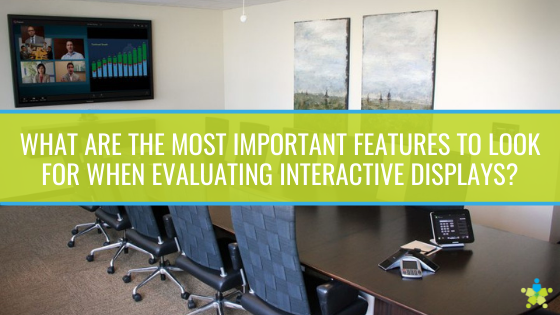
What Are The Most Important Features To Look For When Evaluating Interactive Displays?
[vc_row][vc_column][vc_column_text]
What Are The Most Important Features To Look For When Evaluating Interactive Displays?
Interactive displays are a proven tool in driving engagement, collaboration, and learning. They’re growing in popularity, too, according to a 2020 study by Futuresource Consulting. It projected a 30 percent increase in classroom interactive displays by the end of 2022, and with many schools turning to hybrid instruction, interactivity will only become more important as time marches on. Futuresource also reported that 20% of corporate spending that was once used for conference rooms is now being spent on collaborative technologies, including interactive displays. More schools and businesses than ever are considering the value of interactive displays. What features, though, should they be considering? There’s a lot, but five of the most important include:- Hardware quality
- Controllability
- Supporting software
- Connectivity
- Security
High Quality Displays Are Made With High Quality Hardware
Modern interactive displays are built with LED screens, as LEDs are unmatched in lifespan, energy efficiency and performance. Ideally, that screen will output 4K resolution for optimal image quality so people who aren’t as close to the display can still see clearly. There’s also value in a screen that’s shielded from damage. Displays made for the classroom, for example, are typically made with an additional layer of safety glass that’s perfect for active classrooms. Interactive displays are a valuable tool in conjunction with video conferencing, and some models come with a microphone built-in. This means during a conferencing session, users can work and conference simultaneously at the display without dealing with additional hardware.[/vc_column_text][vc_column_text]Precision Control Maximizes Productivity And Minimizes Frustration
If a technology’s primary selling point is its interactivity, then it better offer precision controls. For interactive displays, that means a screen that can recognize handwriting and reproduce it accurately. It also means a screen that can differentiate between pressure levels and different forms of contact. This is a bigger deal than it seems. If a user can draw with their finger and erase with their palm, they don’t have to change tools back and forth. This saves a lot of time and prevents train-of-thought-derailing interruptions. Multi-point touch is another feature of leading interactive displays, and one to target. Some displays allow for 10 or more simultaneous points of touch, so multiple people can use the screen at once. That’s handy for times when students are working together to brainstorm and problem solve at the display, as well as gesture control like pinch to zoom in and out.[/vc_column_text][vc_column_text]The Best Interactive Displays Are Backed By Excellent Software
Leading display manufacturers include software so users can get the most from their system right away. A strong software package can make a huge difference in a display’s value, so look for the following:- Modern whiteboarding software - At the minimum, your interactive display should come with a regularly updated, intuitive whiteboarding program. The best whiteboarding software is versatile in application in that it’s appropriate for both corporate and educational use. Even better, if your whiteboarding software links to cloud drives or to a browser, you can bring in media resources to enhance presentations.
- Lesson building software - Educators spend a lot of time making lessons and can save a lot of time with lesson building software. In minutes, teachers can piece together visually focused lectures and exercises in any subject, with any content. Once done, store those lessons for future use and share them with other educators.
- A software portal for more solutions - Good software is a start, but what if your teachers could download additional applications and resources for their lessons? Some display manufacturers also maintain their own educational ecosystems. Inside, educators can search for, download and share free applications that can be used for better lesson making.
- Digital Signage – Clevertouch panels come with a built in digital signage app that includes web based solutions for creation and pushing content to the screen.


